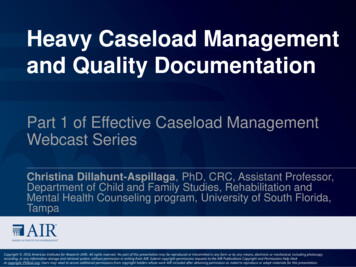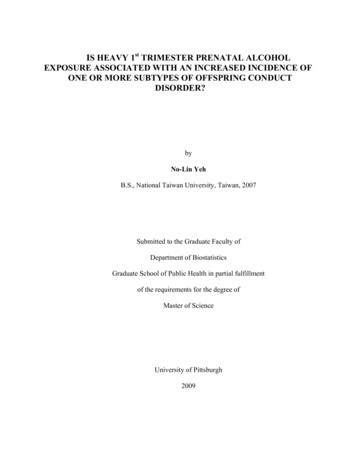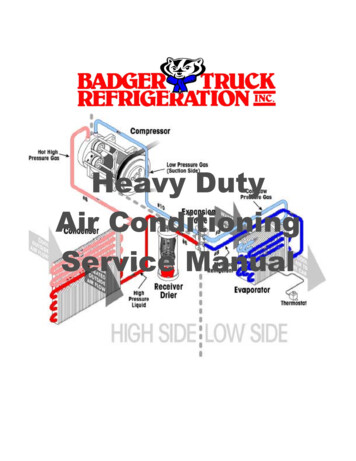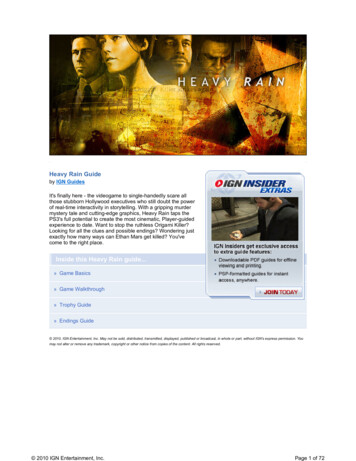
Transcription
Heavy Caseload Managementand Quality DocumentationPart 1 of Effective Caseload ManagementWebcast SeriesChristina Dillahunt-Aspillaga, PhD, CRC, Assistant Professor,Department of Child and Family Studies, Rehabilitation andMental Health Counseling program, University of South Florida,TampaCopyright 2016 American Institutes for Research (AIR). All rights reserved. No part of this presentation may be reproduced or transmitted in any form or by any means, electronic or mechanical, including photocopy,recording, or any information storage and retrieval system, without permission in writing from AIR. Submit copyright permissions requests to the AIR Publications Copyright and Permissions Help Deskat copyright PS@air.org. Users may need to secure additional permissions from copyright holders whose work AIR included after obtaining permission as noted to reproduce or adapt materials for this presentation.
PresenterChristina Dillahunt-Aspillaga, PhD, CRC,Assistant Professor, Department of Child andFamily Studies, Rehabilitation and Mental HealthCounseling program, University of South Florida,Tampa.2
Overview of Presentation Section One: Caseload Management Section Two: Quality Documentation Section Three: Evidenced-Based Practicesin Case Management3
Caseload ManagementQuestion: Which of the following tasks areassociated with Case Management?– Intake Interviewing– Service Coordination– Case Recording– Case Reporting– All of the Above4
Caseload Management DefinitionAccording to the CRCC Scope of PracticeStatement:Case Management is a systematic processmerging counseling and managerial concepts andskills through the application of techniques derivedfrom intuitive and researched methods, therebyadvancing efficient and effective decision-makingfor functional control of self, client, setting, andother relevant factors for anchoring a proactivepractice.5
Caseload Management RolesIn case management, the counselor's role isfocused on:– interviewing,– counseling,– planning rehabilitation programs,– coordinating services,– interacting with significant others,– placing clients and following up with them,– monitoring progress, and– solving problems6
Additional Job TasksOften times vocational counselors have additionaltasks which may include:– vocational assessment– vocational counseling– job placement and related counseling– job development– job accommodation and modification– referral to and collaboration with vendors– case documentation & report writing (computer software)– continuing education & training7
Effective Case Management? Rehabilitation Counselors are beingencouraged to pursue evidenced basedpractices. Time is a limiting factor for counselors andis an important consideration. Time management principles are key alongwith knowledge of best practice models ofVR.8
Time Management Principles Create a system that works for you andadhere to it Analyze how much time is required in eachtask Budget/allow for the unexpected Assess the uncontrollable Delegate an minimize the involvement ofroutine and repetitive tasks9
Time Management Principles Consolidate similar tasks (Emails) Use primetime for prime work Avoid procrastination and identify timewasters Provide a healthy reward your self forreaching your goal/completing your tasks10
Work Log/Time Map Use of a weekly calendar is an effective tool. The best time map allows the counselor toview one full week’s work activities andincludes a space to record goals and actionplans. Be sure to include quiet catch-up timeeveryday. Allow for 5 minutes of quiet meditation per day.11
BurnoutStress producing factors inherent in CM jobs– Extensive client contact– Caseload responsibilities– Negative and disappointing case outcomes– Variety of client emotions– Cases may be open for along time without full resolution– Quantity vs Quality dilemma12
Reducing Burnout Leave the client and their case at the office Try not to take it personally Do your best in every situation Ask for clarification of work roles and realisticgoals Seek advice from supervisors or coworkers Avoid office drama and gossip Be positive and grateful13
Reducing Burnout Learn how to handle stress more effectively Learn meditation techniques Use your vacation time for vacation! Create a calm office environment if possible Eat lunch away from the computer screen Create diversions from stressful aspects of thejob that cannot be changed14
Review and Learning Check Planning, managing, and evaluating are key tocounselor success. Once plans are determined consider allocationand management of time Time management principles covered in thissection can help increase effectiveness. The next sections will cover qualitydocumentation and evidenced-based VRpractices15
Quality Documentation16
Case Recording & Case Documentation Case recording & case documentation areterms that are frequently used interchangeably. Is it correct to use these termsinterchangeably?17
Case Recording Individual counselor contributions to casefolder/file development. This can include:– Factual information– Subjective information18
Case Documentation Case folder/file contributions from the totality ofresources that affect the clients rehabilitationefforts. Examples include:– Workers’ compensation records– Academic records– Medical reports– Vocational reports19
Client, Counselor & Company Case recording is used to facilitate the clientcounselor relationship. Appropriate case recording and reviewfacilitate counselor understanding of the clientand contributes to sound management of thecase. Case recording & documentation areimportant for successful administration &supervision.20
Common Recording Styles Counselor flexibility helps improve skills incase recording. Common styles of recording include:– Recording on established forms– Summary recording– Process or verbatim recording– Research recording– Narrative recording.21
Recording on Established Forms Rehabilitation agencies have basic standardsfor case recording & often use a caseworkmanual and standardized forms. This includes:– Cover/face sheet– History– Work History22
Other Types of Recording Summary Recording Process or Verbatim Receding for Research Purposes Narrative Recording23
Elements of Case RecordingAll recorded information must– Use accurate and reliable information– Not include contradictory or confusing information– Be concise and consistent with client behavior anddisability– Include observations that state facts not opinions– Be written using professional language24
Approaches to Case RecordingCounselors must use a systematic stepwise approach whenrecording cases.Figure 1. Effective Case Recording from Grubbs et al., 200525
Steps Step 1: Record information immediately afterthe after session Step 2: Use a format or guide to organize andrecord data Step 3: Make your decision and acceptresponsibility26
Steps Step 4: Be able to differentiate Objective vs.Subjective data Step 5: Record significant data Step 6: Consult when necessary27
Case Development & DocumentationFigure 2. Rehabilitation Documentation Hexagon from Grubbs et al., 200528
Legal Considerations Counselor awareness of potential legal actions Be knowledgeable of rules that may vary stateto state. The Sunshine Law in Florida29
Evidence-Based Practices inCase Management30
Evidence-Based Practices Pressure to adopt evidenced-based practices The EBP model requires counselors to poseimportant questions and use research prior toservice provision This can be a challenge due to researchtraining, different practice environments,clients, and counselor roles31
EBP The effectiveness of VR counseling has beendemonstrated but there is a lack of EBPs. Limited research is available on the types ofservices that might contribute to employmentrates of disability subpopulations. Determining the appropriate approaches foreach client and client situation can bechallenging.32
Literature Review In 2012 Fleming and colleagues conducted aliterature review to examine 25 years ofrehabilitation research focusing on activeemployment interventions and best practices. Service categories were based on contentreviews.33
Service Categories 11. Interagency collaboration2. Counselor education and consumeroutcomes3. Services to a targeted support group4. Supported employment and EBP5. Empowerment and customer self-concept6. Essential elements of service delivery7. Misc. VR services and outcomes34
Results- Interagency collaboration Interagency collaboration– Most numerous studies.– On the practitioner level interagency collaborationsprovide access to resources and services that might nototherwise be available.35
Services to Target GroupWhat services are most important to the targetgroup? Services for specific populations are related tosuccessful outcomes– For example, with the TBI population Johnstone et al.1found that counseling that increased customerawareness of deficits and tailored assessment,placement, and vocational guidance counseling affectedemployment outcomes.36
Supported Employment (SE) Many studies have researched SEapproaches.– For example, Individual Placement and Support Model(IPS) Overall, research suggests that SE and EBPsfor clients with severe disabilities lead toimproved employment outcomes by providinga varying range of intense and individualizedsupport services.37
Empowerment & Customer Self-Concept Studies found a positive relationship betweenempowerment, self-concept, consumerinvolvement, satisfaction, quality of life, andcommunity reintegration and employmentoutcomes. VR services that include/addressempowerment and self-concept may increaseinvolvement, service satisfaction and improveemployment outcomes.38
Essential Elements of Service Delivery Research indicates important information forservice provision– Make clients feel welcome and connected!– Target interventions (improving life and social skills andfunctioning)– Consider the way services are provided (teamwork higher placement, customer service, staff collaborationand making connections)39
Misc. VR Outcomes Working Alliance (better improvedemployment outcomes) Assistive technology (Counselors benefit formadditional training) Family-focused services( including family canlead to better outcomes) Labor market analysis (LMSs are useful toolsand can improve employment outcomes)40
Summary EBP is valued and is here to stay. Take opportunities to stay up-to-date on EBPand research.– Ask for disability specific trainings.– Attend conferences when possible. Being knowledgeable of effective VR servicedelivery practice can help promote outcomesfor individuals with disabilities.41
References Adcock, R. L., & Lee, J. W. (1972). Principles of time management. A PracticalApproach to Organization Development through MBO., Addison-Wesley,Publishing Company, Reading, Massachusetts, 282-285. Austin, C. D., & McClelland, R. W. (1996). Case management in the humanservices. Reflections of public policy. Journal of case management, 6(3), 119126. Chan, F., Leahy, M. J., & Saunders, J. L. (Eds.). (2005). Case Management forRehabilitation Health Professionals. Aspen Professional Services. Chan, F., Rosenthal, D. A., & Pruett, S. R. (2008). Evidence-based practice inthe provision of rehabilitation services. The Journal of Rehabilitation, 74(2), 3. Chronister, J. A., Chan, F., da Silva Cardoso, E., Lynch, R. T., & Rosenthal, D.A. (2008). The evidence-based practice movement in healthcare: Implicationsfor rehabilitation. Journal of Rehabilitation, 74(2), 6. Commission on Rehabilitation Counselor Certification (CRCC). RehabilitationCounseling Scope of Practice. Retrieved ctice42
References Fleming, A. R., Del Valle, R., Kim, M., & Leahy, M. J. (2012). Best practicemodels of effective vocational rehabilitation service delivery in the publicrehabilitation program: A review and synthesis of the empirical literature.Rehabilitation Counseling Bulletin, 0034355212459661. Grubbs, L. A. R., Cassell, J. L., & Mulkey, S. W. (2005). Rehabilitationcaseload management: Concepts and practice. Springer Publishing Company. Johnstone, B., Mount, D., Gaines, T., Goldfader, P., Bounds, T., & Pitts, Jr, O.(2003). Race differences in a sample of vocational rehabilitation clients withtraumatic brain injury. Brain Injury, 17(2), 95-104. Lundberg, C. C., Rainsford, P., Shay, J. P., & Young, C. A. (2001). Case writingreconsidered. Journal of Management Education, 25(4), 450-463. Maslach, C., & Florian, V. (1988). Burnout, job setting, and self-evaluationamong rehabilitation counselors. Rehabilitation Psychology, 33(2), 85. Pruett, S. R., Swett, E. A., Chan, F., Rosenthal, D. A., & Lee, G. K. (2008).Empirical evidence supporting the effectiveness of vocational rehabilitation.Journal of Rehabilitation, 74(2), 56.43
References Public Business: Miscellaneous Provisions, Chapter 286 (Fl. Stat. 2012). Roessler, R. T., & Rubin, S. E. (2006). Case management and rehabilitationcounseling: Procedures and techniques. PRO-ED, Inc. 8700 Shoal Creek Blvd,Austin, TX 78757. Sunshine Law, Chapter 286 (Fl. Stat. 2012). Upton, T.D. & Beck, R. (2002). Case Management: Rehabilitation applicationsand administrative implications. Journal of Rehabilitation Administration, 26(1)39-46. Wheaton, J. E., & Berven, N. L. (1994). Education, experience, and caseloadmanagement practices of counselors in a state vocational rehabilitationagency. Rehabilitation Counseling Bulletin. Woodside, M., McClam, T., Diambra, J., & Kronick, R. F. (2003). So You Wantto Major in Human Services: An Exploration of Students' Motivations. HumanService Education, 23(1), 53-65.44
Wrapping UpThank you for participating! We invite you to:– Provide your input on today’s webcast– Share your thoughts on future webcasts topics– Participate in the Community of Practice to continue the dialogue PLEASE CONTACT US: ktdrr@air.orgPlease fill out the brief evaluation form:http://bit.ly/2gBRBDq45
DisclaimerThis presentation was developed for grant number90DP0027 from the National Institute on Disability,Independent Living, and Rehabilitation Research(NIDILRR), Administration for Independent Living(ACL), U.S. Department of Health and HumanServices (HHS). However, the contents do notnecessarily represent the policy of the Departmentof HHS, and you should not assume endorsementby the federal government.46
Caseload Management Definition According to the CRCC Scope of Practice Statement: Case Management is a systematic process merging counseling and managerial concepts and











